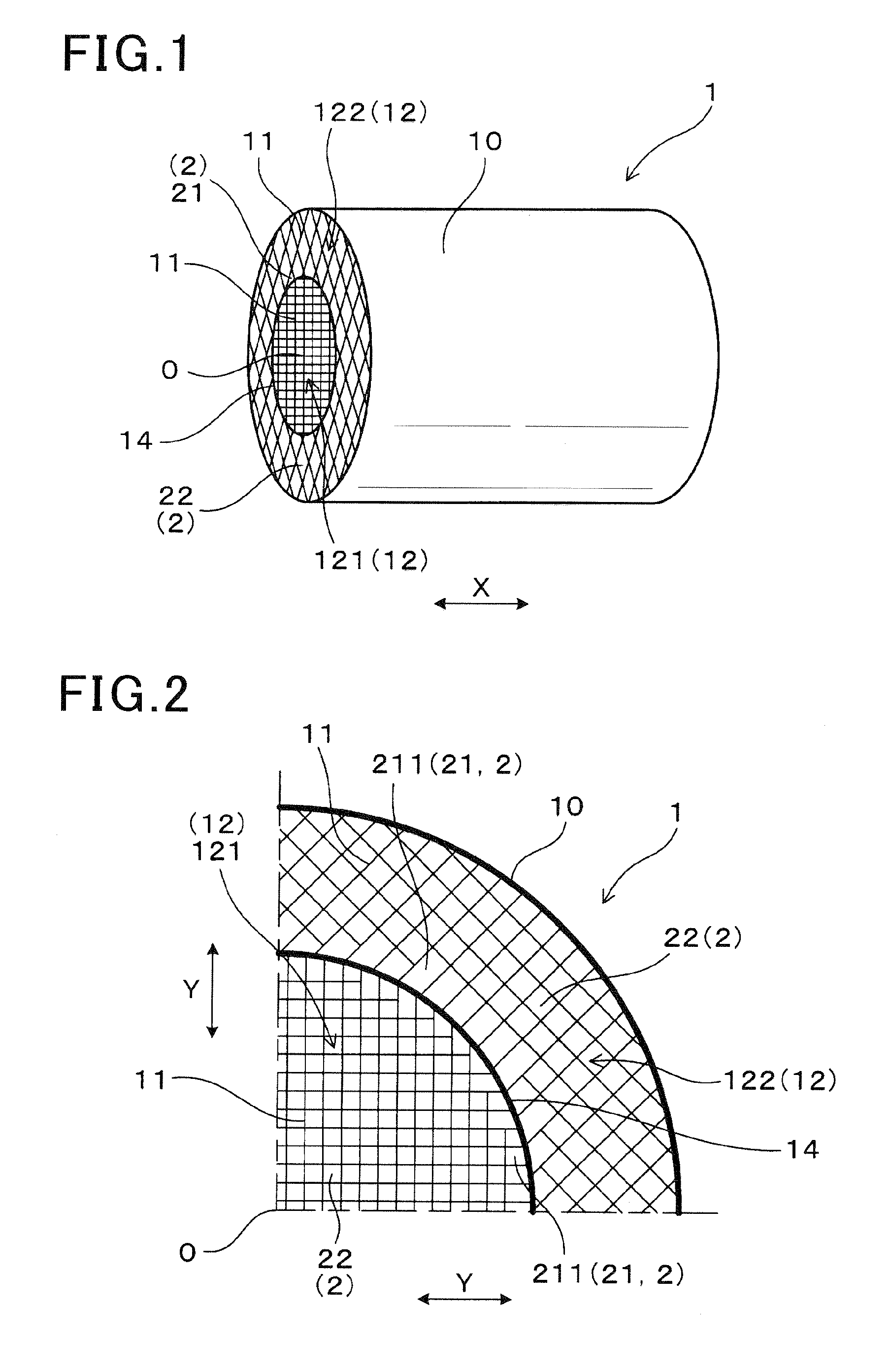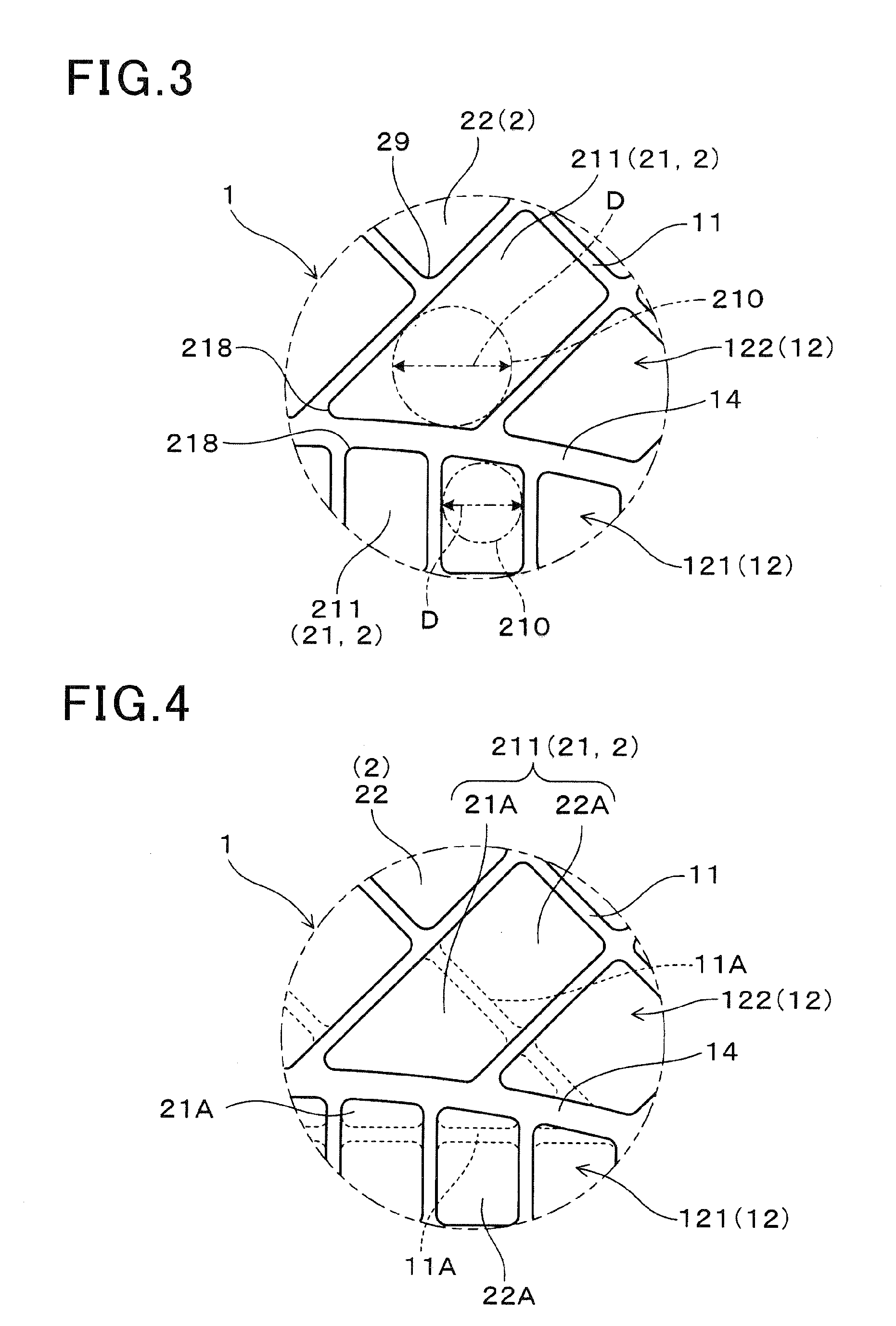Honeycomb structure body
a technology of honeycomb and structure body, which is applied in the direction of machines/engines, physical/chemical process catalysts, separation processes, etc., can solve the problems of reducing the productivity of honeycomb structure bodies having a correct roundness, easy breakage of honeycomb structure bodies, and difficulty in producing honeycomb structure bodies with correct roundness, so as to improve the mechanical strength of honeycomb structures, avoid the structure of honeycombs, and prevent the generation of defects in honeycomb structures
- Summary
- Abstract
- Description
- Claims
- Application Information
AI Technical Summary
Benefits of technology
Problems solved by technology
Method used
Image
Examples
first exemplary embodiment
[0058]A description will be given of various test samples according to exemplary embodiment of the honeycomb structure body and comparative examples.
[0059]The first exemplary embodiment prepared test samples E1 to E6 as the honeycomb structure body according to the first exemplary embodiment and comparative examples C1 to C5, and evaluated these samples.
[0060]A description will now be given of the test samples E1 to E6 according to the first exemplary embodiment.
[0061]FIG. 1 is a perspective view showing an overall honeycomb structure body 1 according to the first exemplary embodiment. FIG. 2 is a view showing a partial cross section in a radial direction of the honeycomb structure body (test samples E1 to E6) according to the first exemplary embodiment shown in FIG. 1.
[0062]As shown in FIG. 1 and FIG. 2, the honeycomb structure body 1 is made of ceramics and has an outer peripheral wall 10 having a cylindrical shape, partition walls 11 arranged in a lattice shape in the interior se...
second exemplary embodiment
[0130]A description will be given of the honeycomb structure body according to the second exemplary embodiment.
[0131]The honeycomb structure body according to the second exemplary embodiment (test samples E7 to E10, and comparative samples C6 to C9) has the first and second cell density sections having different cell densities.
[0132]In particular, the first cell density section in the honeycomb structure body (test samples E7 to E10, and comparative samples C6 to C9) according to the second exemplary embodiment is different in cell density from the first cell density section of the honeycomb structure body according to the first exemplary embodiment (test samples E1 to E6, and comparative samples C1 to C5). Further, the second cell density section in the honeycomb structure body (test samples E7 to E10, and comparative samples C6 to C9) according to the second exemplary embodiment is different in cell density from the second cell density section of the honeycomb structure body (test...
third exemplary embodiment
[0137]A description will be given of the honeycomb structure body according to the third exemplary embodiment.
[0138]The honeycomb structure body according to the second exemplary embodiment (test samples E11 to E14, and comparative samples C10 to C13) has two cell density sections, each having a different cell density. In particular, the first cell density section in the honeycomb structure body according to the third exemplary embodiment (test samples E11 to E14, and comparative samples C10 to C13) is different in cell density from the first cell density section of the honeycomb structure body according to the first and second exemplary embodiment previously described. Further, the second cell density section in the honeycomb structure body according to the third exemplary embodiment (test samples E11 to E14, and comparative samples C10 to C13) is different in cell density from the second cell density section of the honeycomb structure body according to the first and second exempla...
PUM
| Property | Measurement | Unit |
|---|---|---|
| Length | aaaaa | aaaaa |
| Diameter | aaaaa | aaaaa |
| Radius | aaaaa | aaaaa |
Abstract
Description
Claims
Application Information
 Login to View More
Login to View More - R&D
- Intellectual Property
- Life Sciences
- Materials
- Tech Scout
- Unparalleled Data Quality
- Higher Quality Content
- 60% Fewer Hallucinations
Browse by: Latest US Patents, China's latest patents, Technical Efficacy Thesaurus, Application Domain, Technology Topic, Popular Technical Reports.
© 2025 PatSnap. All rights reserved.Legal|Privacy policy|Modern Slavery Act Transparency Statement|Sitemap|About US| Contact US: help@patsnap.com



